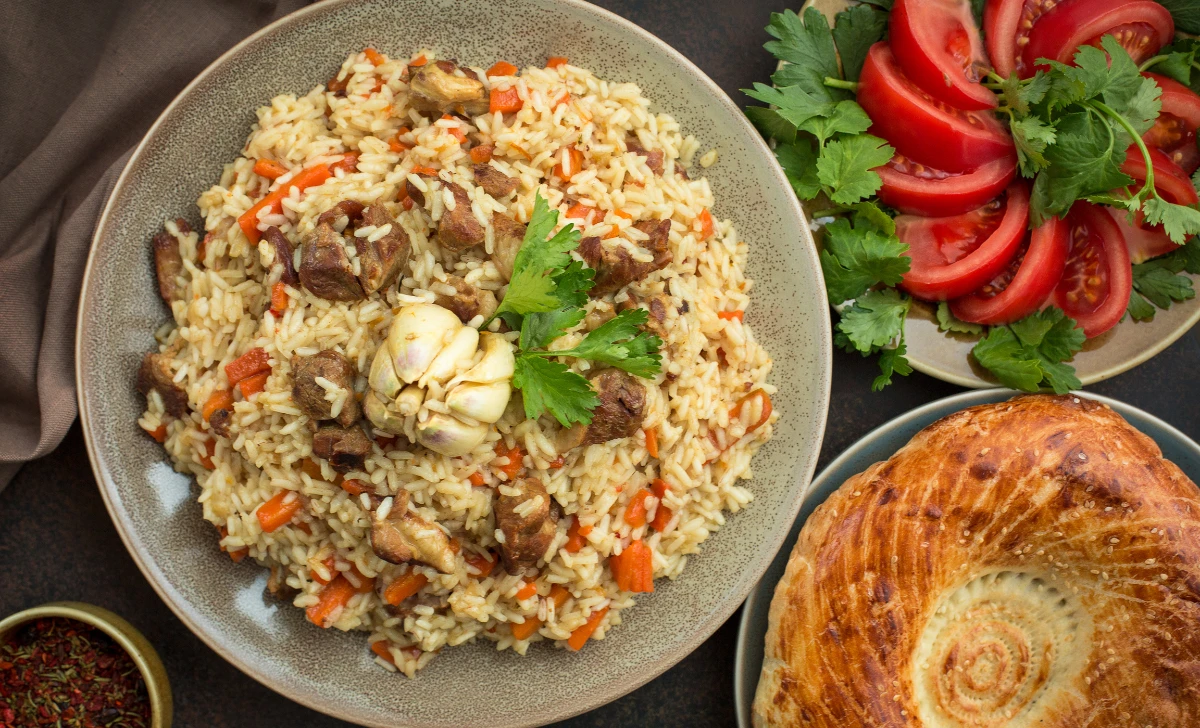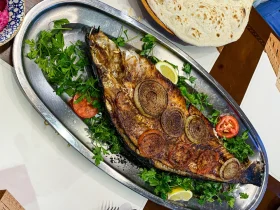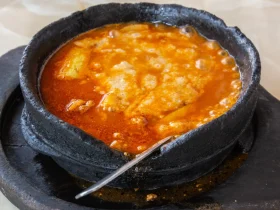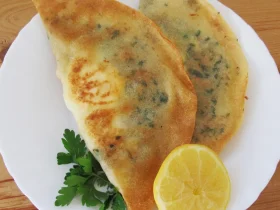Are you ready to embark on a culinary adventure that will tantalize your taste buds and warm your soul? Look no further than this ultimate beef plov recipe. Plov, a traditional dish hailing from Central Asia, is a medley of flavors and textures that will transport you to the heart of the Silk Road. In this article, we’ll dive into the art of crafting the perfect beef plov, step by step. From selecting the finest ingredients to achieving the ideal balance of flavors, we’ve got you covered. Let’s get started on this delightful journey!
[ez-toc]
History
Behind every delectable dish lies a story woven with cultural threads and historical influences. The tantalizing aroma of beef plov carries with it the echoes of centuries past, tracing its roots back to the crossroads of the Silk Road and the heart of Central Asia.
The Silk Road Connection
Picture a bustling network of trade routes that spanned across Asia, connecting the East to the West. This was the Silk Road, a conduit for not only goods but also ideas, languages, and, of course, culinary traditions. Along these ancient pathways, cultures mingled and exchanged, leaving an indelible mark on the cuisines they encountered.
Birthplace and Evolution
Beef plov, also known as “pilaf” or “palov,” finds its origin in the regions of Central Asia, which encompasses modern-day Uzbekistan, Tajikistan, Kyrgyzstan, and beyond. As nomadic communities traversed these lands, they carried with them the essentials of their sustenance—meat, rice, and aromatic spices.
Over time, these staples were woven into the culinary fabric of the region, giving birth to plov. Its evolution was shaped by the availability of ingredients and the distinct influences of various cultures that crisscrossed Central Asia. Persian, Arab, Mongolian, and Indian influences all left their mark, resulting in the rich tapestry of flavors and techniques that define plov.
Symbolism and Celebration
Beyond its role as a meal, plov carries cultural and social significance. It’s often prepared for gatherings, celebrations, and communal feasts. The communal preparation of plov, where family and friends come together to cook, is a testament to its role in fostering unity and connection.
Legacy and Adaptations
As time marched forward, plov continued to adapt and transform. It journeyed beyond Central Asia’s borders, making its way to neighboring countries and even reaching far-flung corners of the world. Each culture added its own twist, incorporating local ingredients and techniques while keeping the essence of plov intact.
Today, whether enjoyed in a humble home or a lavish restaurant, beef plov stands as a flavorful testament to the history of the Silk Road and the culinary legacy it left behind. With every savory bite, we take a step back in time, savoring the heritage and stories of a bygone era.
Time
| Step | Time Required |
|---|---|
| Sautéing Onions to Golden Perfection | 10 minutes |
| Adding Meat: Sealing in Juices and Essence | 15 minutes |
| Rice Joins the Party: Absorbing Flavorful Infusion | 10 minutes |
| The Slow Dance of Simmering and Steaming | 20 minutes |
Ingredients
| Ingredient | Quantity |
|---|---|
| Tender Beef (cubed) | 250 grams |
| Long-Grain Rice | 1 cup |
| Onion (medium, finely sliced) | 1 |
| Carrot (medium, julienned) | 1 |
| Garlic Cloves (minced) | 3 |
| Cumin Seeds | 1 teaspoon |
| Paprika | 1 teaspoon |
| Ground Coriander | 1/2 teaspoon |
| Bay Leaves | 2 |
| Vegetable Oil | 3 tablespoons |
| Salt | To taste |
| Black Pepper | To taste |
| Fresh Cilantro or Parsley (chopped) | For garnish |
Feel free to adjust the quantities based on your preferences and dietary needs. Enjoy your cooking adventure!
Directions
1. Sautéing Onions to Golden Perfection
- Heat 2 tablespoons of vegetable oil in a large, heavy-bottomed pot over medium heat.
- Add the finely sliced onions and sauté them until they turn a glorious golden brown. This might take around 5-7 minutes.
- Once the onions are beautifully caramelized, transfer them to a plate and set them aside. They’ll make a triumphant return to our plov masterpiece later.
2. Adding Meat: Sealing in Juices and Essence
- In the same pot, add another tablespoon of vegetable oil if needed. Turn up the heat to medium-high.
- Add the cubed beef to the pot and let it sizzle and sear. We’re aiming for that delightful brown crust on the outside.
- Stir occasionally and let the beef cook until it’s no longer pink on the outside. This should take about 5-7 minutes.
- Toss in the minced garlic, cumin seeds, paprika, and ground coriander. Let the spices mingle and dance with the beef for about a minute, releasing their aromas.
3. Rice Joins the Party: Absorbing Flavorful Infusion
- Pour in the julienned carrots and give everything a good mix. The carrots are joining the beef and spices for a delightful flavor fiesta.
- Add the washed and drained rice to the pot. Stir everything together, allowing the rice to get cozy with the aromatic wonders.
- Carefully pour in 2 cups of water. Toss in the bay leaves, and season with salt and black pepper to taste.
- Bring the mixture to a gentle boil, then lower the heat to a simmer. Cover the pot with a lid and let it work its magic. This is where the flavors meld and the rice absorbs the essence of the beef and spices. Allow it to simmer for around 15 minutes.
4. The Slow Dance of Simmering and Steaming
- After the 15-minute mark, give the rice a gentle fluff with a fork. You’ll notice it’s soaked up much of the liquid, but it’s not quite done yet.
- Lower the heat even more, cover the pot with a kitchen towel, and then put the lid back on. This helps trap steam and creates the perfect environment for the rice to finish cooking.
- Let the plov simmer and steam for an additional 10-15 minutes, or until the rice is tender and each grain stands separate and proud.
5. Garnishes and The Big Reveal
- Remove the pot from the heat and let it sit, covered, for about 10 minutes. This gentle rest lets the flavors settle and mingle.
- Remove the bay leaves and give the plov a final fluff with a fork.
- Sprinkle the freshly chopped cilantro or parsley over the plov. This adds a burst of freshness and color to the dish.
- It’s time for the big reveal—scoop the fragrant plov onto plates and let the aroma enchant your senses.
6. Savoring the Sensation: Tasting and Enjoying
- With a fork in hand, take that first tantalizing bite. Let the flavors dance on your palate, and savor the harmony of tender beef, aromatic rice, and spices that tell stories of distant lands.
- Experience the delightful contrast of textures as you journey from the succulent beef to the tender rice grains.
7. Final Touches: Sharing and Enjoying
- Gather around the table and share this culinary treasure with loved ones.
- As you savor each bite, take a moment to appreciate the journey this dish has taken—from the Silk Road to your kitchen.
Bon appétit!
Equipment Required
Nutrition Information
| Nutrient | Amount Per Serving |
|---|---|
| Serving Size | 1 plate (approx. 350g) |
| Calories | 450 |
| Total Fat | 15g |
| Saturated Fat | 4g |
| Trans Fat | 0g |
| Cholesterol | 50mg |
| Sodium | 700mg |
| Total Carbohydrate | 60g |
| Dietary Fiber | 4g |
| Sugars | 3g |
| Protein | 20g |
| Vitamin D | 0% |
| Calcium | 6% |
| Iron | 15% |
| Potassium | 8% |
Note: Nutritional values are approximate and can vary based on specific ingredients used.
Enjoy your delicious and nutritious beef plov while knowing the approximate nutritional content it provides!
Tips
- Rice Rule: Choosing the Right Grain for the Job Opt for long-grain rice like Basmati or Jasmine. Their slender grains will absorb flavors without turning mushy.
- Spice Symphony: Balancing Flavors Like a Maestro Adjust the spice quantities to your preference. If you’re a spice lover, feel free to turn up the heat. For a milder experience, scale back a bit.
- Marination Magic: Letting the Beef Luxuriate Allow the beef to marinate for at least 30 minutes, or even better, overnight. This deepens the flavors and ensures every bite is a burst of delight.
- Crisp Carrot Crunch: Timing Is Key Add the julienned carrots when you’re almost done searing the beef. This keeps the carrots vibrant and slightly crunchy, adding a delightful texture to the plov.
- Loving the Low Heat: Slow and Steady Wins the Race When simmering and steaming the rice, resist the urge to crank up the heat. Low and slow cooking ensures each grain of rice is perfectly tender.
- Lid and Towel Trick: Fluffiness Magic Covering the pot with a kitchen towel before putting on the lid creates a seal that allows the rice to steam to fluffy perfection.
- The Waiting Game: Patience Pays Off Letting the plov rest after cooking lets the flavors meld and the rice grains firm up. It’s worth the wait!
Pros & Cons
| Pros | Cons |
|---|---|
| ✔️ Bursting with Flavor | ❌ Time-Intensive |
| ✔️ Rich Cultural Heritage | ❌ Requires Multiple Ingredients |
| ✔️ Hearty and Satisfying | ❌ High Sodium Content |
| ✔️ Customizable Ingredients | ❌ Calorie-Dense |
| ✔️ Great for Sharing | ❌ Potential for Overcooking Rice |
Conclusion
As we reach the end of our culinary adventure, the aromas of the Silk Road linger in the air, reminding us of the rich history and tradition that accompanies each bite of beef plov. This dish is not just a meal; it’s a voyage through time, a fusion of cultures, and a celebration of flavors that transcend borders.
From the sizzle of sautéed onions to the tender embrace of marinated beef, from the fragrant symphony of spices to the fluffy grains of rice, every element comes together to create a masterpiece that tantalizes the senses and warms the heart.
Sure, preparing beef plov demands a bit of time and effort, but the rewards are immeasurable. The smiles of satisfaction around the table, the camaraderie as you share this delicious creation with loved ones, and the sense of accomplishment as you savor each bite—all of these experiences make the journey worthwhile.
So, whether you’re a seasoned cook or a culinary adventurer embarking on your very first dish, I urge you to roll up your sleeves, embrace the spices, and embark on your own plov-making expedition. Let the aromas transport you, the flavors captivate you, and the history enrich you. With a pot of beef plov before you, you hold not just a meal, but a piece of history and a testament to the enduring power of food to connect us across time and space.
Bon appétit, and happy plov-making!
Facts
- 1. A Journey Through Time: The Plov Time Capsule 🕰️
- Did you know that plov’s history dates back thousands of years? Archaeological finds suggest that a similar dish was enjoyed by ancient civilizations along the Silk Road, making plov not just a meal but a taste of history on your plate.
- 2. Spice Story: The Secret Behind Plov’s Aroma 🌶️
- The spices used in plov aren’t just for flavor; they have stories to tell! Cumin, a key spice, was believed to protect against evil spirits in ancient times. So when you sprinkle cumin into your plov, you’re not just seasoning—you’re keeping the culinary spirits at bay.
- 3. The “Golden Crust” Mystery: Plov’s Enigmatic Bottom Layer 🥘
- Ever wondered about that golden crust at the bottom of the plov pot? It’s called “tahdig” in Persian cuisine. In plov, it’s known as “zirvak” and is considered a coveted delicacy. It’s the result of rice crisping up in the fragrant juices, making it an extra treat for those in the know.
- 4. Plov Diplomacy: A Symbol of Hospitality 🍽️
- In Central Asia, plov isn’t just a meal; it’s a cultural symbol of hospitality and unity. When a pot of plov is cooked, it’s often shared with neighbors, friends, and even strangers, embodying the spirit of communal dining and friendship.
- 5. The Quest for the Perfect Bite: Plov Contests! 🏆
- Plov competitions are a big deal in some countries! These culinary battles bring together master chefs to showcase their plov prowess. It’s a feast for the senses as participants vie for the title of the most mouthwatering plov on the block.
FAQ’s
What makes plov different from other rice dishes?
Plov stands out for its rich blend of flavors. The combination of marinated meat, aromatic spices, and perfectly cooked rice creates a symphony of tastes that’s unique to this Central Asian delicacy.
Can I use different types of rice for plov?
Absolutely! Long-grain rice like Basmati or Jasmine works best, but you can experiment with other varieties. Just ensure they have a good texture and can absorb flavors well.
Is marinating the meat essential?
Marinating adds depth to the beef’s flavor, but if you’re short on time, you can skip it. However, marinating enhances the taste experience, so it’s recommended if you can spare the extra time.
Can I substitute beef with chicken?
Of course! Chicken plov is a delicious alternative. Use boneless chicken pieces and adjust the cooking time accordingly. Marinate the chicken similarly to achieve flavorful results.
What are some creative garnishing ideas for plov?
Alongside the classic cilantro or parsley, you can try toasted nuts like almonds or pine nuts for added crunch. Pomegranate seeds or even yogurt drizzle also add a delightful contrast.
Can I prepare plov in advance?
While plov is best enjoyed fresh, you can definitely prepare it a few hours ahead and gently reheat it when needed. Just sprinkle a bit of water and steam it covered on low heat.
How do I prevent the rice from becoming mushy?
To avoid mushy rice, make sure to rinse the rice thoroughly until the water runs clear before cooking. Also, fluff the rice gently with a fork during the cooking process and avoid stirring too much.
What’s the best way to store leftover plov?
Allow any leftover plov to cool to room temperature, then refrigerate it in an airtight container. Reheat portions as needed, adding a touch of water if necessary to restore moisture.
Can I make a vegetarian version of plov?
Absolutely! Swap out the meat for your favorite vegetables like bell peppers, carrots, and peas. You’ll still get a deliciously flavorful rice dish without the meat.
How can I adjust the spice level to my preference?
Feel free to adjust the quantity of spices to suit your taste. Start with a smaller amount and gradually add more until you reach your desired level of heat and flavor.












Leave a Review